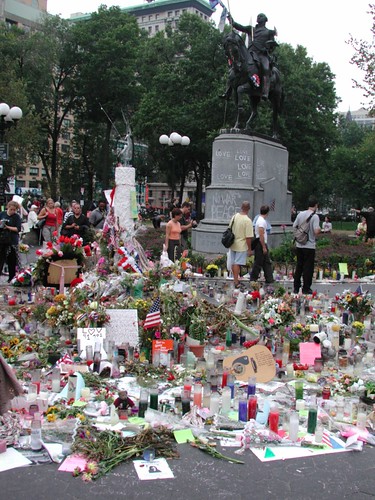Just the thought of Mike Bloomberg and Bette Midler together makes me giddy.
Mayor Michael R. Bloomberg and New York Restoration Project (NYRP) Founder Bette Midler today launched the Million Trees NYC initiative to plant and care for one million trees throughout the five boroughs in the next decade. The Mayor and Ms. Midler planted a street tree in the Morrisania section of the Bronx – a neighborhood with too few trees and high rates of asthma – and declared the Carolina Silverbell to be the first of one million trees.
– Press release, Tuesday, October 9, 2007
And if not for the much-needed rain tonight, we could see that the Empire State Building is lit green to note today’s kickoff.
Not once do they mention the botanical name of the tree, Halesia carolina. It’s a lovely, graceful tree. I don’t know how it fares as a street tree in NYC. It’s native to the southeastern United States. It’s in the Styracaceae, the Storax or Snowball family.
The nomenclature for this genus seems confused. Wikipedia lists H. carolina as a synonym for H. tetraptera, but the USDA Plants database identifies the latter as a different species, the mountain silverbell, with two subspecies. I’ll defer to USDA Plants as the authority.
None of the four species of Halesia are native to New York state. According to the Atlas of the New York Flora Association, both H. carolina and H. tetraptera are known as escapes in the wild.
The Parks Department will receive nearly $400 million over the next ten years to plant 600,000 public trees by reforesting 2,000 acres of existing parkland and lining New York City streets with trees. The City’s partners, including non-profit and community organizations, businesses, developers and everyday New Yorkers will plant the remaining 400,000 trees.
There are many ways to get involved in Million Trees NYC:
- plant a tree in your yard;
- join a volunteer group planting trees in parks and on public land;
- request that the City plant street trees on your block;
- learn how to water, mulch, and prune trees;
- educate other New Yorkers on the importance of our urban forest; and
- become an advocate for planting trees.
Each request for a street tree will trigger an evaluation of the suggested site by a Parks department inspector. Considerations such as electrical wires, underground utilities, light posts and building entrances will be part of the inspection. If it is possible to plant a tree in the site requested, a tree planting contractor will be assigned to plant the tree in the next possible planting season, in either the spring or fall.
Links
Halesia carolina (USDA Plants Database)
Million Trees NYC Web site (also in the sidebar under Links > NYC)
New York Restoration Project (Bette Midler’s joint, also in the sidebar)
Related Posts
April 22: 1M Trees in 10 Years

